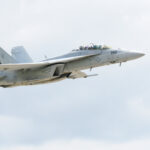
The Marine Corps has carried out the first nighttime landings of its variant of the F-35 Joint Strike Fighter aboard a ship. The F-35B, which features a short-take off and vertical-landing capability (STOVL), touched down on the amphibious assault ship USS Wasp (LHD-1) on Wednesday, during the second round of at-sea developmental testing. The F-35B 's first night landing aboard the USS Wasp (LHD-1). Photo by U.S. Navy The landings mark a key point for a program that has been plagued…











